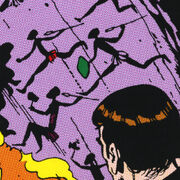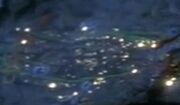
Cave paintings on Neesan
Cave paintings were crudely drawn sketches usually found on the walls of a cave. They were usually created by cavemen, humanoids in Stone Age cultures, and could endure for thousands of years.
History[]
During his life in the 2700s BC on Sarpeidon, Zar often made cave paintings. When he was brought to the year 2270 by his father Spock, he drew in sketchbooks. Technician Teresa McNair considered Zar a talented artist. (TOS novel: Yesterday's Son)
In 2153, T'Pol reflected on an ancient cave painting which depicted an enraged Vulcan warrior. She compared the painting’s expression with that on Charles Tucker III’s face upon hearing of the death of his sister in the Florida attack, the first time she’d seen an expression of revenge. (ENT novel: The Expanse)
In 2266, Leonard McCoy thought newly painted, jewel-encrusted cave paintings on Neesan looked similar to ancient ones seen in Altamira. (TOS comic: "The Cosmic Cavemen")
Wwafida were considered to be a legendary race of undersea humanoids on Akkalla, with depictions of them found on cave paintings produced 10,000 years ago. Zzev Kkayn had theorized that they were not mythological, but actually an extension the Akkallan life cycle following a metamorphosis, and that they continued to exist in the 23rd century. While investigating in 2278, he, James T. Kirk and Spock entered a cave full of elaborate paintings depicting the lives of Wwafida, which still had vibrant pigmentation despite their age. (TOS novel: Deep Domain)
In 2284, Museum of the South Pacific Curator Galarrwuy Nayingul of Easter Island and Kirk discussed the Australian phenomena and ritual of Dream-time, which seemed to allow for precognition, as evidenced by ancient cave paintings of airplanes on Earth. (TOS novel: Strangers from the Sky)
In 2366, the computers aboard the USS Enterprise-D had a record of all notable art made on Earth, including paleolithic cave paintings. (TNG novel: Gulliver's Fugitives)
Kathryn Janeway had seen cave paintings on Betair VII, reminiscent of those she saw in 2372 on Sardalia of hunters attacking a sea animal. She thought that the Sardalian paintings were similar in style to art from the Nesclun Moon Pygmy religion. (VOY novel: Bless the Beasts)

Hanara on a stone artifact.
In 2373, an Anschlasom group stranded on a planet mapped their travels on stones in a cave. The Mikhal Traveler Zahir gave USS Voyager’s nurse Kes one of the stones, which pinpointed Hanara in the Delta Quadrant. An image of it was reviewed by Project Full Circle. (VOY episode: "Darkling", VOY novels: Children of the Storm, Full Circle)
Cave painting sites[]
- Akkalla (Akkallan)
- Altamira
- Betair VII
- Earth (Humans)
- Hanara (Anschlasom)
- Neesan (Tol tribe)
- Sardalia (Sardalian)
- Sarpeidon (Zar)
- Vulcan
